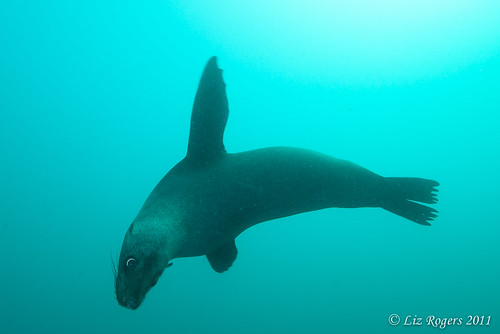Seals are of the Pinniped order, which means that they are “fin-footed”. They have two flippers in the front (forelimbs) and two at the back (hind limbs), with which they swim in the water as well as walk about on land. Eared seals belong to the Otariidae family and earless seals (or true seals) to the Phocidae family.
There are 32 different seal species. These range in size, weight, distribution and other characteristics (colour, mating habits, and so on). The largest is the southern elephant seal (with an impressive weight of about two tons or 4 000 pounds) and the smallest is the Galapagos fur seal, which weighs only about 65 pounds. Seals are found in waters all over the world, extending all the way from the icy poles to the equatorial coastlines.

Some seal skulls.

Sea Lion Skeleton.
Because they are semi-aquatic and semi-terrestrial, seals need to be able to move around both in water and on land. Therefore, some seals are able to rotate their black flippers to become effective ‘feet’ while they are on land. They can move fairly fast, although their movements always appear to be somewhat cumbersome. When they enter the water, their back flippers revert to being just that, and they are able to cut through the water at speed, using the movements of their body to propel themselves forward. Other seals (known as true seals) cannot rotate their back flippers. Rather, they drag themselves along the ground with the front flippers. When these seals swim, they make effective use of the hind fins to add thrust to their movement.
Like cetaceans, seals have a thick layer of blubber directly under their skin. This insulates them and protects them from the cold water and, if applicable, the icy environment. This blubber also gives them buoyancy and is an important source of energy.
Those seals that live in hotter climates need to keep cool while they are out of the water. Therefore, they often flap sand onto themselves to create a barrier from the sun. Most pinnipeds moult on a yearly basis to replace their skin and fur, which becomes worn over time. This means remaining on the shore for extended periods of time in some cases, being particularly vulnerable.
Seals, like other pinnipeds, have a unique and complex breathing system that enables them to hold their breath for extended periods of time without becoming buoyant (due to keeping a “balloon” of air inside them) or having to resurface more regularly. They can stay underwater for up to 40 minutes at a time.
Seals become sexually mature between the ages of three and six years (in females) and three and seven years (in males). The degree of male aggression in terms of reproduction differs between the various seal species. Some are extremely aggressive and territorial, while others remain less so. Females can begin mating soon after birth because they use a method of delayed embryo implantation. There is a gestation period of 11 months and pups are born in spring and summer so that they may benefit from the most temperate conditions. They are prepared for their marine lives almost immediately as they enter the ocean’s waters soon after birth. Nursing is not continued for very long. Some pups are weaned after four days, while others are nursed for as long as one month. This is due to the fact that the mother does not usually eat anything while she is nursing. Therefore, the period needs to be cut short so that she can regain her strength and rebuild her blubber, an important source of energy. Pups instinctively become independent of their mother (as opposed to being trained by her to live an independent life).
As carnivores, seals eat fish, squid, crustaceans, penguins and even other marine mammals. They are not generally picky about their diet, but will eat what is available.
Seals continue to be hunted for their fur, pelts and blubber in some parts of the world. This leaves many of the very young without their mother. They are also threatened by pollution and global warming (for those that rely on the ice for survival). Their natural enemies comprise killer whales and polar bears.

